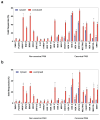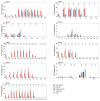Continuous directed evolution of a compact CjCas9 variant with broad PAM compatibility
- PMID: 37735239
- PMCID: PMC7616171
- DOI: 10.1038/s41589-023-01427-x
Continuous directed evolution of a compact CjCas9 variant with broad PAM compatibility
Abstract
CRISPR-Cas9 genome engineering is a powerful technology for correcting genetic diseases. However, the targeting range of Cas9 proteins is limited by their requirement for a protospacer adjacent motif (PAM), and in vivo delivery is challenging due to their large size. Here, we use phage-assisted continuous directed evolution to broaden the PAM compatibility of Campylobacter jejuni Cas9 (CjCas9), the smallest Cas9 ortholog characterized to date. The identified variant, termed evoCjCas9, primarily recognizes N4AH and N5HA PAM sequences, which occur tenfold more frequently in the genome than the canonical N3VRYAC PAM site. Moreover, evoCjCas9 exhibits higher nuclease activity than wild-type CjCas9 on canonical PAMs, with editing rates comparable to commonly used PAM-relaxed SpCas9 variants. Combined with deaminases or reverse transcriptases, evoCjCas9 enables robust base and prime editing, with the small size of evoCjCas9 base editors allowing for tissue-specific installation of A-to-G or C-to-T transition mutations from single adeno-associated virus vector systems.
© 2023. The Author(s), under exclusive licence to Springer Nature America, Inc.
Conflict of interest statement
L.S. and G.S. have filed a patent application based on evolved
Figures











Similar articles
-
Engineering CjCas9 for Efficient Base Editing and Prime Editing.CRISPR J. 2024 Dec;7(6):395-405. doi: 10.1089/crispr.2024.0018. Epub 2024 Nov 18. CRISPR J. 2024. PMID: 39556313
-
Improving Plant Genome Editing with High-Fidelity xCas9 and Non-canonical PAM-Targeting Cas9-NG.Mol Plant. 2019 Jul 1;12(7):1027-1036. doi: 10.1016/j.molp.2019.03.011. Epub 2019 Mar 27. Mol Plant. 2019. PMID: 30928637
-
High-throughput continuous evolution of compact Cas9 variants targeting single-nucleotide-pyrimidine PAMs.Nat Biotechnol. 2023 Jan;41(1):96-107. doi: 10.1038/s41587-022-01410-2. Epub 2022 Sep 8. Nat Biotechnol. 2023. PMID: 36076084 Free PMC article.
-
Developing Heritable Mutations in Arabidopsis thaliana Using a Modified CRISPR/Cas9 Toolkit Comprising PAM-Altered Cas9 Variants and gRNAs.Plant Cell Physiol. 2019 Oct 1;60(10):2255-2262. doi: 10.1093/pcp/pcz118. Plant Cell Physiol. 2019. PMID: 31198958
-
CRISPR technologies and the search for the PAM-free nuclease.Nat Commun. 2021 Jan 22;12(1):555. doi: 10.1038/s41467-020-20633-y. Nat Commun. 2021. PMID: 33483498 Free PMC article. Review.
Cited by
-
Rationally designed Campylobacter jejuni Cas9 enables efficient gene activation and base editing.Mol Ther Nucleic Acids. 2024 Oct 18;35(4):102366. doi: 10.1016/j.omtn.2024.102366. eCollection 2024 Dec 10. Mol Ther Nucleic Acids. 2024. PMID: 39558904 Free PMC article.
-
Engineering of CRISPR-Cas PAM recognition using deep learning of vast evolutionary data.bioRxiv [Preprint]. 2025 Jan 6:2025.01.06.631536. doi: 10.1101/2025.01.06.631536. bioRxiv. 2025. PMID: 39829748 Free PMC article. Preprint.
-
From bench to bedside: cutting-edge applications of base editing and prime editing in precision medicine.J Transl Med. 2024 Dec 20;22(1):1133. doi: 10.1186/s12967-024-05957-3. J Transl Med. 2024. PMID: 39707395 Free PMC article. Review.
-
Dual SORT LNPs for multi-organ base editing.Nat Biotechnol. 2025 Jun 2. doi: 10.1038/s41587-025-02675-z. Online ahead of print. Nat Biotechnol. 2025. PMID: 40457105
-
Recent advances in therapeutic gene-editing technologies.Mol Ther. 2025 Jun 4;33(6):2619-2644. doi: 10.1016/j.ymthe.2025.03.026. Epub 2025 Mar 20. Mol Ther. 2025. PMID: 40119516 Review.
References
MeSH terms
Substances
Grants and funding
LinkOut - more resources
Full Text Sources
Other Literature Sources
Research Materials
Miscellaneous

